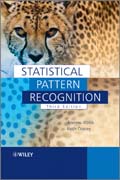
Statistical Pattern Recognition provides an introduction to statistical pattern theory and techniques, with material drawn from a wide range of fields, including the areas of engineering, statistics, computer science and the social sciences. The book describes techniques for analysing data comprising measurements made on individuals or objects. The techniques are used to make a prediction such as disease of a patient, the type of object illuminated by a radar, economic forecast. Emphasis is placed on techniques for classification, a term used for predicting the class or group an object belongs to (based on a set of exemplars) and for methods that seek to discover natural groupings in a data set. Each section concludes with a description of the wide range of practical applications that have been addressed and the further developments of theoretical techniques and includes a variety of exercises, from open-book questions tomore lengthy projects. New material is presented, including the analysis of complex networks and basic techniques for analysing the properties of datasets and also introduces readers to the use of variational methods for Bayesian density estimation and looks at new applications in biometrics and security. INDICE: Preface Acknowledgements Notation 1 Introduction to statistical pattern recognition 1.1 Statistical pattern recognition 1.1.1 Introduction 1.1.2The basic model 1.2 Stages in a pattern recognition problem 1.3 Issues 1.4 Approaches to statistical pattern recognition 1.5 Elementary decision theory 1.5.1 Bayes decision rule for minimum error 1.5.2 Bayes decision rule for minimumerror _ reject option 1.5.3 Bayes decision rule for minimum risk 1.5.4 Bayes decision rule for minimum risk _ reject option 1.5.5 Neyman_Pearson decision rule 1.5.6 Minimax criterion 1.5.7 Discussion 1.6 Discriminant functions 1.6.1 Introduction 1.6.2 Linear discriminant functions 1.6.3 Piecewise linear discriminant functions 1.6.4 Generalised linear discriminant function 1.6.5 Summary 1.7 Multiple regression 1.8 Outline of book 1.9 Notes and references Exercises2 Density estimation _ parametric 2.1 Introduction 2.2 Estimating the parameters of the distributions 2.2.1 Estimative approach 2.2.2 Predictive approach 2.3 The Gaussian classifier 2.3.1 Specification 5 2.3.2 Derivation of the Gaussian classifier plug-in estimates 2.3.3 Example application study 2.4 Dealing with singularities in the Gaussian classifier 2.4.1 Introduction 2.4.2 Naïve Bayes 2.4.3 Projection onto a subspace 2.4.4 Linear discriminant function 2.4.5 Regularised discriminant analysis 2.4.6 Example application study 2.4.7 Further developments 2.4.8 Summary 2.5 Finite mixture models 2.5.1 Introduction 2.5.2 Mixture models for discrimination 2.5.3 Parameter estimation for normal mixture models 2.5.4 Normal mixture model covariance matrix constraints 2.5.5 How many components? 2.5.6 Maximum likelihood estimation via EM 2.5.7 Example application study 2.5.8 Further developments 2.5.9 Summary 2.6 Application studies2.7 Summary and discussion 2.8 Recommendations 2.9 Notes and references Exercises 91 3 Density estimation _ Bayesian 3.1 Introduction 3.1.1 Basics 3.1.2 Recursive calculation 3.1.3 Proportionality 3.2 Analytic solutions 3.2.1 Conjugate priors 3.2.2 Estimating the mean of a normal distribution with known variance 3.2.3 Estimating the mean and the covariance matrix of a multivariate normal distribution 3.2.4 Unknown priorclass probabilities 3.2.5 Summary 3.3 Bayesian sampling schemes 3.3.1 Introduction 3.3.2 Summarisation 3.3.3 Sampling version of the Bayesian Classifier 3.3.4 Rejection sampling 3.3.5 Ratio of uniforms 3.3.6 Importance Sampling 3.4 Markov chain Monte Carlo methods 3.4.1 Introduction 3.4.2 The Gibbs sampler 3.4.3 Metropolis-Hastings algorithm 3.4.4 Data augmentation 3.4.5 Reversible jump Markov chain Monte Carlo 3.4.6 Slice sampling 3.4.7 MCMC Example _ Estimation of Noisy Sinusoids 3.4.8 Summary 3.4.9 Notesand references 3.5 Bayesian approaches to discrimination 3.5.1 Labelled training data 3.5.2 Unlabelled training data 3.6 Sequential Monte Carlo Samplers 3.6.1 Introduction 3.6.2 Basic Methodology 3.6.3 Summary 3.7 Variational Bayes 3.7.1 Introduction 3.7.2 Description 3.7.3 Fac
- ISBN: 978-0-470-68227-2
- Editorial: John Wiley & Sons
- Encuadernacion: Cartoné
- Páginas: 672
- Fecha Publicación: 07/10/2011
- Nº Volúmenes: 1
- Idioma: Inglés
